I enjoy aliens. I like programs with aliens, I like stories with aliens, generally I just think about aliens a lot. Like, too much. I especially like to get into the Science of Aliens, things like Hypothetical Biochemistries, and exotic evolutionary pathways. And you know what? As much as I usually enjoy the programming they exist in, some aliens kinda piss me off.
There are two main kinds of Aliens that bug me. The first is “Human but Other.” This describes most things you’ll see in programs like Star Trek and Star Wars, due to obvious constraints of makeup and prosthetics. This usually looks like a human, but with some stuff on their face. Or maybe even no stuff on their face. Maybe just some body paint. Maybe not even that. But the story implies they have weird organs or something, so it’s cool right?? That’s the general idea, but this also applies to slightly more exotic things from literature and comics and the like, but nonetheless basically boil down to “a Tiger, but a person” or something like that.
The second type is “Way too Other.” This occurs mostly in written fiction. This is where a writer seems to have been so obsessed with avoiding the first type with making their alien “alien,” they seem to have forgotten they were trying to design an organism. These are the “sentient planet-wide ocean” or “just a blob full of eyes” type. And these can be useful for science fiction, they allow writers to speculate about truly alien thought patterns and to say something about human nature. But they often strike me as something of a trick, as a way to get around being really imaginative about evolution. Once you’ve decided “its a blob” you don’t really need to go into much more detail to get your story going.
There are more than a few standout examples that brilliantly defy both these types, and the personal favorite I’m going to point out is Larry Niven’s Puppeteers.
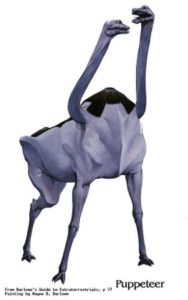
Three-legged, cowardly herbivores with their brains in their back and mouths for hands. You read about these guys and you can really tell Niven thought deeply about what their evolution implied, both about their anatomy and their psychology, both as individuals and on a larger cultural scale. Their body plan differs from anything on Earth completely, without generalizing it into something practically abiotic. Plus they’re fun to read about, and can be used to say something about humans here at home.
These are the sorts of aliens I hope to imitate in my own thought and writing. Clearly an organism, but obviously and entirely distinct from most anything seen on this Earth, particularly us featherless bipeds. When I consider alien evolutionary patters (and I do. I really do a lot) I go back to the very source of things like anatomical structure and life itself, and imagine fundamental differences, while still retaining that fundamental quality of life. I thought I’d share those methods with my peers here on the interwebs.
So, without further ado, here’s my guide to Alien Design. Disclaimer: I am not a biologist, I am in no way formally educated or specialized in this field. I am however, a fairly intelligent, extremely nerdy individual who, as I’ve said repeatedly, thinks about this kind of crap a lot.
For the purposes of this lesson, I’ll be demonstrating my methods on an alien of my own design. I call them the Qlai.
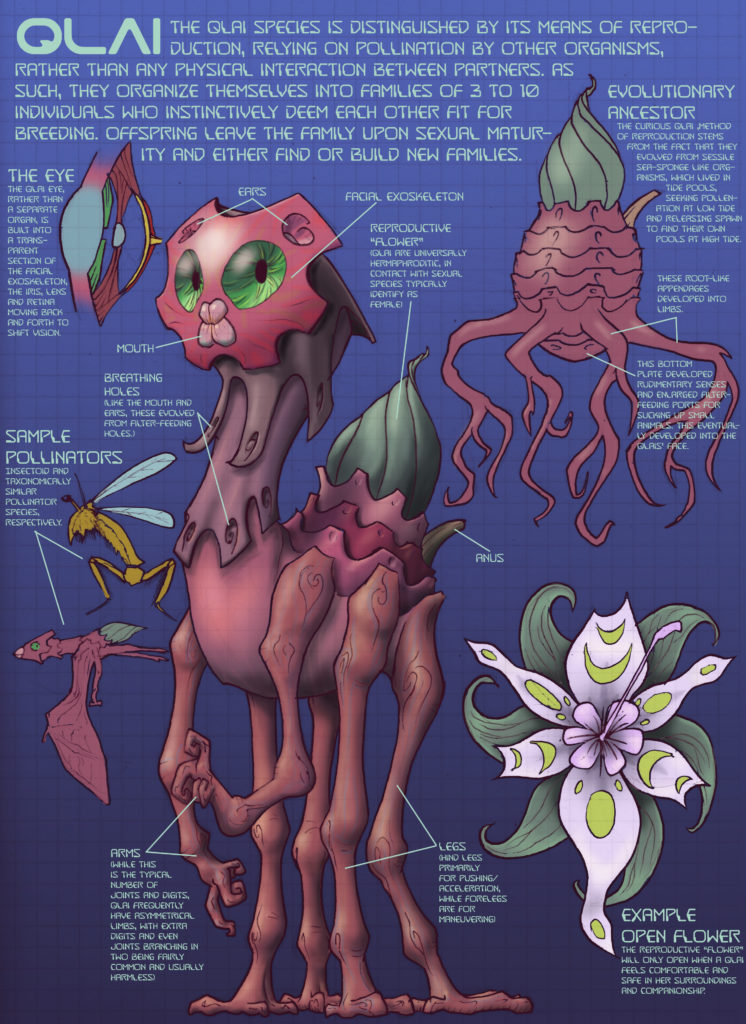
I’ve been thinking about these guys for quite a while, so I have their nature more or less down. Here’s how I figured them out.
I find a good starting point for making aliens is to pick a trait, something fundamental to them, like a body plan or a food source, or a method of reproduction, and then work backwards, then forwards. First ask, “what early evolutionary conditions would cause that trait to arise,” then ask “what other traits might build out of that trait, and those conditions that caused it.” For the Qlai, that trait was that, despite being a mobile, sapient animal, they reproduce through pollination, relying on other organisms to transmit gametes to each other, rather than engaging in any physical intercourse. This is a good trait to pick, because it automatically separates the Qlai from any Earth-born species of animal, it speaks volumes about their evolution, and it deeply informs how they would structure their society.
So what would cause this trait to evolve in an early organism? Well, if they were some sort of sessile (non moving), filter-feeding animal, like an anemone or sea sponge, the use of pollination would make sense, as they’d have no way of coming in contact with others of their species. But those animals simply spit their gametes into the water, relying on swimming action and diffusion to get them to comparable equals. So I devised that the Qlai ancestors must have evolved in a kind of tide pool, seeking pollination when exposed at low tide, then releasing their spawn into the water at high tide to find other pools to root in. So, I decided their ancestor might look like this:
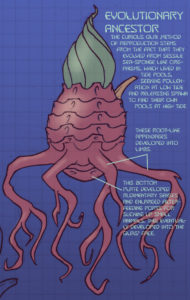
From such a system, we may assume they come from a planet with one or two large moons, to produce tides, implying a large planet with above-Earth gravity. Which implies, given the premie that there are flying animals on this world, that the atmosphere is moderately denser and more oxygen-rich than Earth. These little details may not seem important, but they help inform the nature of your alien.
But how does such an organism evolve into a sapient alien? Well, perhaps the “roots” actually held it slightly above the sand, to avoid sucking sand into its filter-feeding ports. But then it “realized” (in an evolutionary sense) that it could also suck up small animals that crawled under it. This accessible form of nutrients would be aided by enlarged holes on that bottom plate, the ability to suck up rocks and sand into a kind of gizzard for grinding up the prey, slight movement by the roots, and eventually rudimentary senses in the bottom plate to help track the prey, and a basic nervous system to interpret the input. Eventually the “roots” become more like limbs, gaining a rough symmetry, and that bottom plate becomes something like a face, with four of the six feeding ports merging into a mouth, the other two adapting into a sort of eardrum, and basic photoreceptors becoming more complex until an eye develops.
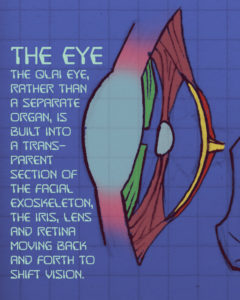
The eye is particularly interesting, evolving from receptors behind the “skull” rather than in front of it. Rather than being an individual organ capable of moving around within a cavity, the eye develops behind transparent “lens” formation in the exoskeleton, the iris, lens, and retina moving around behind it to shift vision. Oddly this may give the impression that a Qlai is looking in the opposite direction that they are. While it may seem to human facial recognition that the Qlai in the image is looking at the viewer, it is in fact looking dead ahead, and would likely seem to be looking to its right were it looking at us from that angle. Notably, because this means the face is the most armored part of the body and the back of the head and brain are less defended, Qlai will typically face directly anything which frightens or intimidates them directly, only treating those they trust with aside glances. Thus to humans they seem more courageous than they might be, while humans seem oddly cautious to them, always making eye contact.
While it might not come out in a story you’re telling, it’s important to consider what other animals from your aliens’ planet may have evolved from the same ancestor. How extensive and diverse is that taxa? How many different niches do they fill? Note that on Earth mammals, birds, reptiles, arthropods and others all include herbivores, carnivores, and scavengers, and vary greatly in size, from blue whales to tiny bats, from dinosaurs to garden lizards, from emus to hummingbirds. Take for example this related pollinator species, distinct from, yet clearly sharing traits with it’s sapient cousin.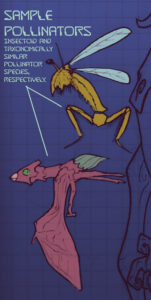 Note also the other, distinct insect like species, which still has clear differences from body plans found on Earth for similar organisms. Both of these evolved in tandem with the Qlai flower
Note also the other, distinct insect like species, which still has clear differences from body plans found on Earth for similar organisms. Both of these evolved in tandem with the Qlai flower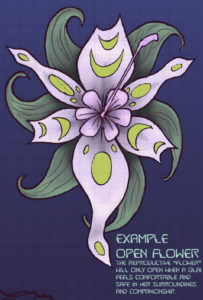 seen on the right, and the smaller organism no doubt has its own, even smaller pollinators.
seen on the right, and the smaller organism no doubt has its own, even smaller pollinators.
From there, it’s important to consider how your species evolved intelligence. It can be enough to simply assume they did, but the exact manner can help further inform their biological and psychological nature. Take humans. We were apes, adapted to climb and grasp trees, who were slowly excised from the jungle into sparsely wooded and flatland areas without the adaptations for them. Thus we adapted to use our branch-grabbing limbs to construct and use tools, which required greater intelligence, which enabled more complex tools, etc. (this is obviously a simplification and the exact cause of human intelligence is still debated, but I digress)
For the Qlai, what I ended up coming up with was that, after eons of using the “grind up food in a gizzard” method of chewing, lacking actual jaws aside form their four mandible-like appendages around their mouth, a small group of a species of predators found themselves pushed into a desert-like area, where small rocks useable in a gizzard were more difficult to find. As a result, their forelimbs, already adapted to grabbing prey and forcing it into the mouth, became more complex and delicate, to enable them to pull their food apart into digestible bits. As food then evolved to be less pull-apartable, poisonous, or otherwise difficult to acquire, the Qlai ancestors had to develop more nuance and skill to dismember their prey and avoid poisonous areas, necessitating greater intelligence and tool use.
As they moved into more habitable climates, these adaptations remained. The Qlai reversed their evolved skill to build, rather than dismantle, almost immediately constructing complex devises out of wood and stone. As a result, Qlai are generally viewed as excellent tinkerers and inventors, many focussing this skill by doing other tasks backwards, setting the mind for the reverse of the skill that evolved their intelligence.
Qlai language is very complex, having almost no real consonants besides a sort of glottal since sound is produced as a series of hums from any of the six major (lower) and six minor breathing holes on the neck, which lack mouths or tongues. “Qlai” is simply the closest sound to the series of coincident hums by which the Qlai refer to themselves.
Because of their mode of reproduction, the Qlai do not have “mates” as it were, the discovery of “paternity” and the exact link between birth and the animals than pollenate them having been a major scientific discovery on par with cell theory. Rather they instinctively collect into families, generally of three to ten, of others they subconsciously deem worthy of breeding with. Physical contact is rarely done outside these families and even within them it is rare except for mother and child. When an offspring reaches sexual maturity (i.e. when her flower becomes fully developed) she leaves the family on an instinct to prevent accidental inbreeding, and either finds a new family to join or builds a new one with other adolescents. As a result things like surnames and inheritance are fairly complex in Qlai culture.
As a result of this family dynamic, Space colonization was somewhat difficult for Qlai. While humans could reasonably send a small number of humans and a collection of genetically diverse embryos and raise successive generations on another world, Qlai psychologically require several families to be present to allow the swapping or offspring, necessitating very large missions right away, drastically upping expense.
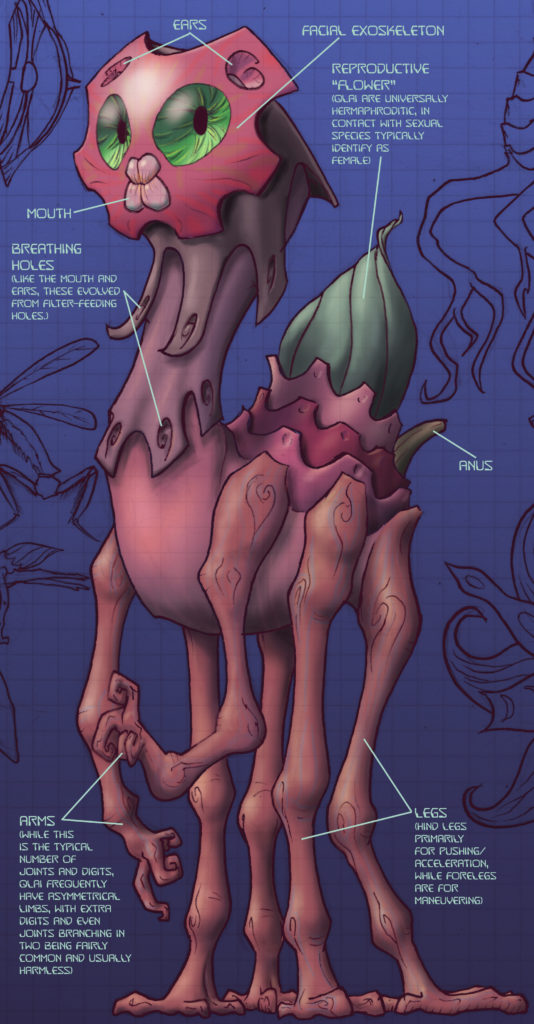
Other aspects of Qlai culture vary greatly, as they would in any species that isn’t from Star Trek. From the use of flower-covering garments in public (though covering the anus is nearly universal) to body-dyeing and other appearance modifications. Most cultures that encourage or enforce the former, and many that don’t will feature “seed houses,” essentially small enclosed zoos with pollenating animals where families can go to enable breeding, without the otherwise inherent risk of external influence. Nonetheless paternity plays very little role in Qlai psychology and culture, and when dealing with sexual aliens, most will prefer to be thought of as female despite being hermaphroditic (calling a Qlai male is rather like calling somebody a sperm donor).
And see, all of that detail, all of that nuance and culture, all arose as a logical conclusion of that single tarting premise of an animal that uses pollination. I started with one trait, an virtually no preconceptions (except that I kind of wanted them to be pink. No real reason for or against that anyway) and it spiraled out into, if I do say so myself, a fairly well-formed species I can write about whenever and however I like. Distinct from anything terrestrial, yet clearly an organism with an evolutionary pattern not all that different form our own.
Any sci-fi writers out there, please feel free to use the guidelines in this post to help design your own aliens. These steps are free to use. Just don’t use the Qlai. These guys are mine.

very nice read love the art will definitely try it out on my alien ideas